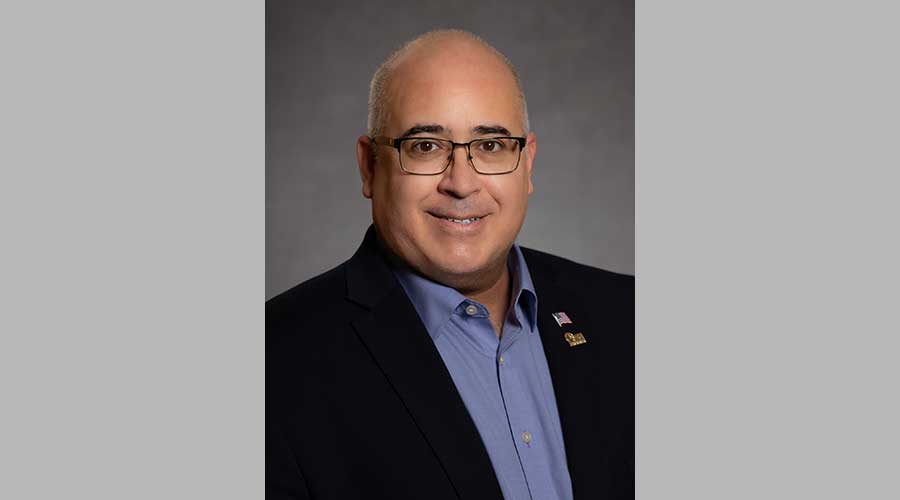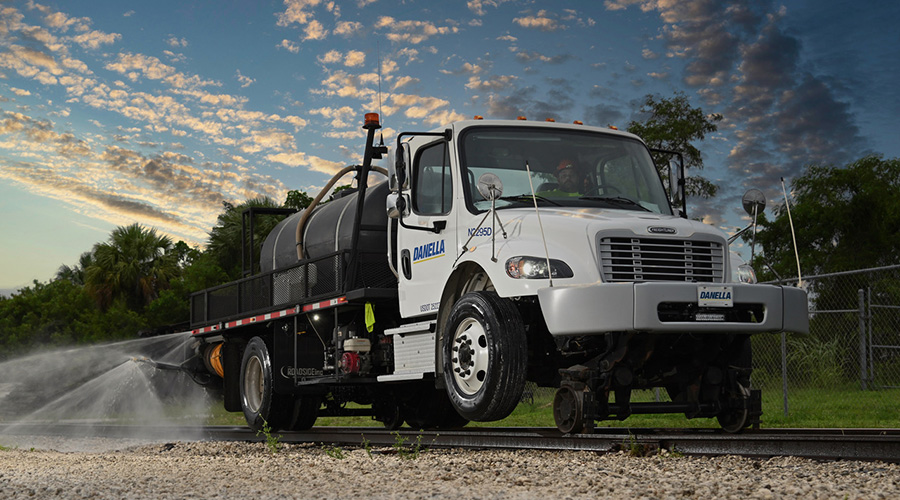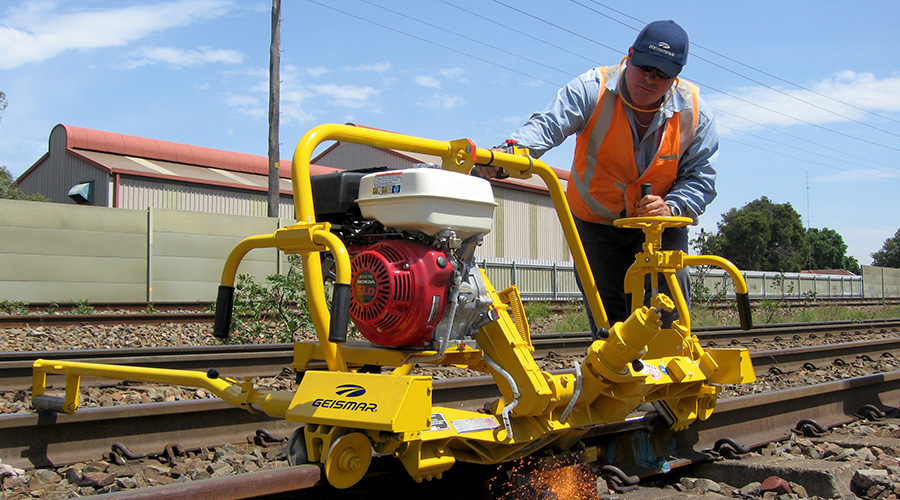Newsletter Sign Up
Stay updated on news, articles and information for the rail industry
Stay updated on news, articles and information for the rail industry
RAIL EMPLOYMENT & NOTICES
Rail News Home MOW
Rail News: MOW
September 2012
Rail News: MOW
AREMA conference attendees hear reports on safety, financial and technical trends
advertisement
By Julie Sneider, Assistant Editor
The general session at the American Railway Engineering and Maintenance-of-Way Association's (AREMA) 2012 Annual Conference and Exposition held Sept. 17 in Chicago offered attendees a keynote message on rail safety from the National Transportation Safety Board (NTSB) chair, an industry update from a Wall Street insider and multiple presentations that covered a host of technical topics.
The keynote address was delivered by NTSB Chairman Deborah Hersman, whose speech was titled, "Walking the Walk of Railroad Safety."
She called on AREMA members to take leadership roles on safety issues in their railroad endeavors. Hersman also cited three tragic accidents that she said resulted from railroads not "walking the walk" on safety: a June 2009 collision between two of the Washington Metropolitan Area Transit Authority's (WMATA) Metrorail trains that killed nine people and injured dozens; a June 2009 CN ethanol train derailment in Cherry Valley, Ill., that killed one, injured seven, caused 600 homes to be evacuated and resulted in $8 million worth of damage; and a September 2008 head-on collision between Union Pacific Railroad and Metrolink trains in Chatsworth, Calif., that resulted in 25 deaths and many injuries.
NTSB investigators determined that the WMATA collision was caused by the train control system’s failure to detect the presence of a train, which resulted in a train entering a section of track occupied by another train.
"When we dug deeper, we found that [WMATA] wasn't minding the store," Hersman said. "In our probable cause, we cited the lack of a safety culture from the top down. ... Safety wasn't even part of [the WMATA board's] mission statement. In short, they didn't track safety, didn't measure it and didn't communicate its importance."
Since then, WMATA has been changing its safety culture for the better.
"Building a culture of trust and respect doesn't happen overnight," Hersman said, adding that management has to be committed and employees have to be willing to "overcome the legacy of distrust" between departments, and learn to cooperate and communicate with each other.
CN's Cherry Valley accident also stemmed from the organization's weak safety culture. The NTSB determined the probable cause of the ethanol train's derailment was a washout discovered an hour before the train arrived at a crossing. The Class I's inadequate emergency communication procedures prevented information from being communicated to the train in time to avoid the washout, Hersman said.
But she also recognized CN for swiftly tackling its safety problems even before the NTSB issued its post-accident safety recommendations.
The Chatsworth case is an example of safety being more than "policies, rules and efficiency testing," Hersman said. The trains collided after the Metrolink train engineer failed to respond to a red signal because he was texting on his cell phone. Metrolink policy already prohibited cell phone use while operating a train, and although the engineer had been warned many times about his cell phone use, he continued to violate the policy, she said.
The Chatsworth accident did ignite a national debate that resulted in mandated positive train control (PTC) technology, something that had been on NTSB's most-wanted list of transportation safety improvements since 1990, Hersman said. Metrolink committed to being the first commuter-rail agency in the nation to operate its system with PTC — and last week, Hersman was on site in Los Angeles when the agency ran its first test on a fully equipped PTC test train.
She acknowledged that some stakeholders in the rail industry want to delay PTC implementation — which is federally mandated to be completed by the end of 2015 — because of its cost and complexity.
"But that effort is short-sighted because we continue to investigate accidents" that could be prevented by PTC technology, she said.
A rail perspective from the Street
Later in the general session, independent transportation industry analyst and Progressive Railroading columnist Tony Hatch offered his observations of rail industry trends, noting that future growth potential for business includes the areas of intermodal, shale-drilling-related opportunities, chemicals, grain and coal exports.
Although the decline in domestic coal shipments has attracted national attention this year — with The Wall Street Journal declaring it's "the end of the coal age" — the trend has been going on for years and the railroads have been adapting to it with other lines of business, said Hatch.
For example, the rapid expansion of oil and natural gas drilling in the nation's shale plays represents key opportunities for railroads to transport frac sand, water, brine, aggregates and other shale-activity-related carloads, he said. Hatch, who recently toured the Bakken shale-drilling areas of North Dakota, believes the shale business could help lead to a "reindustrialization" of the U.S. economy.
"I saw three pipeline companies building rail facilities," Hatch said of his Bakken shale tour. "And what's happening in North Dakota is just ramping up."
Some of Hatch's other observations of the economic trends impacting rail included: "the green movement is here to stay;' commodities with a less certain future include paper and ethanol; trade will be dynamic but strong; government spending will be "problematic,” but freight railroads' capital expenditures will remain at record levels; and trucking productivity has peaked.
As for the election-year politics that are affecting rail, Hatch suggested the country should "get rid of the notion" that government doesn't need to invest in infrastructure.
An update on the Chicago-to-St. Louis corridor
The AREMA conference also featured a presentation by Philip Pasterak of Parsons Brinckerhoff and David Orrell of Union Pacific Railroad on the public- and private-sector entities that are working together to establish high-speed rail service in the 284-mile Chicago-to-St. Louis corridor. Work on the $1.45 billion project, which is being funded primarily by federal dollars, began in 2010.
Next month, the project will reach a milestone when project officials begin 110-mph service on a 14-mile demonstration segment of the corridor between Dwight and Pontiac, Ill.
And by 2015, all infrastructure will be in place in the corridor to run 110-mph passenger-rail service, Pasterak said.
The general session at the American Railway Engineering and Maintenance-of-Way Association's (AREMA) 2012 Annual Conference and Exposition held Sept. 17 in Chicago offered attendees a keynote message on rail safety from the National Transportation Safety Board (NTSB) chair, an industry update from a Wall Street insider and multiple presentations that covered a host of technical topics.
The keynote address was delivered by NTSB Chairman Deborah Hersman, whose speech was titled, "Walking the Walk of Railroad Safety."
She called on AREMA members to take leadership roles on safety issues in their railroad endeavors. Hersman also cited three tragic accidents that she said resulted from railroads not "walking the walk" on safety: a June 2009 collision between two of the Washington Metropolitan Area Transit Authority's (WMATA) Metrorail trains that killed nine people and injured dozens; a June 2009 CN ethanol train derailment in Cherry Valley, Ill., that killed one, injured seven, caused 600 homes to be evacuated and resulted in $8 million worth of damage; and a September 2008 head-on collision between Union Pacific Railroad and Metrolink trains in Chatsworth, Calif., that resulted in 25 deaths and many injuries.
NTSB investigators determined that the WMATA collision was caused by the train control system’s failure to detect the presence of a train, which resulted in a train entering a section of track occupied by another train.
"When we dug deeper, we found that [WMATA] wasn't minding the store," Hersman said. "In our probable cause, we cited the lack of a safety culture from the top down. ... Safety wasn't even part of [the WMATA board's] mission statement. In short, they didn't track safety, didn't measure it and didn't communicate its importance."
Since then, WMATA has been changing its safety culture for the better.
"Building a culture of trust and respect doesn't happen overnight," Hersman said, adding that management has to be committed and employees have to be willing to "overcome the legacy of distrust" between departments, and learn to cooperate and communicate with each other.
CN's Cherry Valley accident also stemmed from the organization's weak safety culture. The NTSB determined the probable cause of the ethanol train's derailment was a washout discovered an hour before the train arrived at a crossing. The Class I's inadequate emergency communication procedures prevented information from being communicated to the train in time to avoid the washout, Hersman said.
But she also recognized CN for swiftly tackling its safety problems even before the NTSB issued its post-accident safety recommendations.
The Chatsworth case is an example of safety being more than "policies, rules and efficiency testing," Hersman said. The trains collided after the Metrolink train engineer failed to respond to a red signal because he was texting on his cell phone. Metrolink policy already prohibited cell phone use while operating a train, and although the engineer had been warned many times about his cell phone use, he continued to violate the policy, she said.
The Chatsworth accident did ignite a national debate that resulted in mandated positive train control (PTC) technology, something that had been on NTSB's most-wanted list of transportation safety improvements since 1990, Hersman said. Metrolink committed to being the first commuter-rail agency in the nation to operate its system with PTC — and last week, Hersman was on site in Los Angeles when the agency ran its first test on a fully equipped PTC test train.
She acknowledged that some stakeholders in the rail industry want to delay PTC implementation — which is federally mandated to be completed by the end of 2015 — because of its cost and complexity.
"But that effort is short-sighted because we continue to investigate accidents" that could be prevented by PTC technology, she said.
A rail perspective from the Street
Later in the general session, independent transportation industry analyst and Progressive Railroading columnist Tony Hatch offered his observations of rail industry trends, noting that future growth potential for business includes the areas of intermodal, shale-drilling-related opportunities, chemicals, grain and coal exports.
Although the decline in domestic coal shipments has attracted national attention this year — with The Wall Street Journal declaring it's "the end of the coal age" — the trend has been going on for years and the railroads have been adapting to it with other lines of business, said Hatch.
For example, the rapid expansion of oil and natural gas drilling in the nation's shale plays represents key opportunities for railroads to transport frac sand, water, brine, aggregates and other shale-activity-related carloads, he said. Hatch, who recently toured the Bakken shale-drilling areas of North Dakota, believes the shale business could help lead to a "reindustrialization" of the U.S. economy.
"I saw three pipeline companies building rail facilities," Hatch said of his Bakken shale tour. "And what's happening in North Dakota is just ramping up."
Some of Hatch's other observations of the economic trends impacting rail included: "the green movement is here to stay;' commodities with a less certain future include paper and ethanol; trade will be dynamic but strong; government spending will be "problematic,” but freight railroads' capital expenditures will remain at record levels; and trucking productivity has peaked.
As for the election-year politics that are affecting rail, Hatch suggested the country should "get rid of the notion" that government doesn't need to invest in infrastructure.
An update on the Chicago-to-St. Louis corridor
The AREMA conference also featured a presentation by Philip Pasterak of Parsons Brinckerhoff and David Orrell of Union Pacific Railroad on the public- and private-sector entities that are working together to establish high-speed rail service in the 284-mile Chicago-to-St. Louis corridor. Work on the $1.45 billion project, which is being funded primarily by federal dollars, began in 2010.
Next month, the project will reach a milestone when project officials begin 110-mph service on a 14-mile demonstration segment of the corridor between Dwight and Pontiac, Ill.
And by 2015, all infrastructure will be in place in the corridor to run 110-mph passenger-rail service, Pasterak said.


 2025 MOW Spending Report: Passenger-rail programs
2025 MOW Spending Report: Passenger-rail programs
 Gardner steps down as Amtrak CEO
Gardner steps down as Amtrak CEO
 Guest comment: Oliver Wyman’s David Hunt
Guest comment: Oliver Wyman’s David Hunt
 Women of Influence in Rail eBook
Women of Influence in Rail eBook
 railPrime
railPrime







